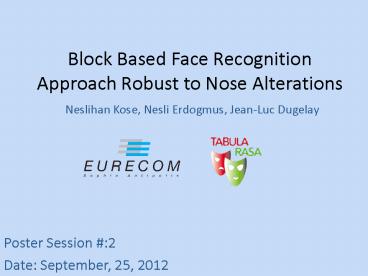Block Based Face Recognition Approach Robust to Nose Alterations - PowerPoint PPT Presentation
1 / 18
Title:
Block Based Face Recognition Approach Robust to Nose Alterations
Description:
... (rhinoplasty) is used which is prepared using FRGC v1.0 in this study. It is obvious that the recognition performances decrease after nose alterations. – PowerPoint PPT presentation
Number of Views:17
Avg rating:3.0/5.0
Title: Block Based Face Recognition Approach Robust to Nose Alterations
1
Block Based Face Recognition Approach Robust to
Nose Alterations
- Neslihan Kose, Nesli Erdogmus, Jean-Luc Dugelay
Poster Session 2 Date September, 25, 2012
2
Block Based Face Recognition Approach Robust to
Nose Alterations
- Proposed approach
- A simulated nose altered face database
(rhinoplasty) - is used which is prepared using FRGC v1.0 in this
study. - It is obvious that the recognition performances
- decrease after nose alterations.
- In this paper, we focus on developing a new
- approach which reduces the impact of nose
alterations on recognition performances. - The proposed approach analyses images by
- dividing them according to a regular square grid.
Fig. (a) Nose region with landmark points, color
map, depth map and profile view for the target
model (b) Same images for the source model (c)
Two models superimposed before and after
alignment, resulting mesh after warping and
profile view for the synthesized model
- Key Results
- The block based face recognition approach
improves the results significantly both in 2D and
3D face recognition. - The analyses are not restricted to 2D, the effect
of the proposed approach can be determined also
in 3D. - It is possible to measure the original
performances on FRGC v1.0, an authentic
comparison between pre- and post-alteration
performances is provided.
3
Encoding, Matching and Score Normalization for
Cross Spectral Face Recognition Matching SWIR
versus Visible Data
- Jinyu Zuo, Francesco Nicolo, Natalia A. Schmid,
and Sirisha Boothapati
(a)
(b)
(c)
Sample images of TINDERS dataset gallery visible
image (a), neutral probe SWIR image at 50 meter
of distance (b) and neutral probe SWIR image at
106 meters of distance (c).
Poster Session II Date September 25, 2012
4
Encoding, Matching and Score Normalization for
Cross Spectral Face Recognition Matching SWIR
versus Visible Data
- Proposed approach
- Key Results
Gabor filter (2 scales, 8 orientations)
After Normalization
50 meter
106 meter
5
Face Recognition Impostor-based Measures of
Uniqueness and Quality
- Brendan F. Klare and Anil K. Jain
Poster Session II Date 9/25/2012
6
Face Recognition Impostor-based Measures of
Uniqueness and Quality
- Propose a framework called uniqueness-based
nonmatch estimates (UNE) - Maps face match scores into non-match probability
estimates that are conditionally dependent on the
probe images Impostor-based Uniqueness Measure
(IUM)
- Offers
- Improved generalization of matching thresholds /
accuracy - Score normalization improves interoperability of
different face matchers - IUM predictive of FR accuracy
7
A Group of Facial Normal Descriptors for
Recognizing 3D Identical Twins
- Huibin Li, Di Huang, Liming Chen,
- Yunhong Wang, Jean-marie Morvan
Poster Session Poster Section II and Coffee 10
posters Date Tuesday, September 25, 2012
8
A Group of Facial Normal Descriptors for
Recognizing 3D Identical Twins
- Proposed approach
- Key Results
9
(No Transcript)
10
(No Transcript)
11
Hallucinating Faces in the Dark
- Sasikanth Bendapudi
- Khoa Luu
- Marios Savvides
Poster Session II Date 09/25/2012
12
Hallucinating Faces in the Dark
- Proposed approach
- Key Results
Positive Subspace
Negative Subspace
Original Image
Illumination Estimate
Corrected Image
13
Differentiating Duchenne from Non-Duchenne
Smiles using Active Appearance Models and the
Facial Action Coding System
- Jason Vandeventer, Eric Patterson
- University of North Carolina Wilmington
Poster Session II Date Tuesday, Sept 25 10
a.m.-12 p.m.
14
Differentiating Duchenne from Non-Duchenne Smiles
Study Image Database Feature Extraction Classifier Score
Littlewort et al. (2001) BBC Gabor Filters SVM 75.00
Cohn et al. (1999) Cohn-Kanade (CK) Optical Flow (Lucas-Kanade) Feature Point Distances 82.00
Littlewort et. al. (2001) Ekman-Hager, Pittsburgh Gabor Filters SVM 87.00
Cohn et al. (2004) Cohn-Kanade (CK) Tian, Kanade, and Cohn System Linear Discriminant Analysis 93.00
Valstar et al. (2007) MMI Facial Expression Database GentleBoost SVM 94.00
This Study (2012) Extended Cohn-Kanade (CK), Bosphorus AAM SVM 95.83
15
Analysis of Partial Least Squares for
Pose-Invariant Face Recognition
- Mika Fischer, Hazim K. Ekenel, Rainer
Stiefelhagen - Karlsruhe Institute of Technology
Poster Session 2 Date 9/25/2012
16
Analysis of Partial Least Squaresfor
Pose-Invariant Face Recognition
- PLS is a new approach for comparing faces in
different poses - This work analyzes the different parameters when
using PLS - Alignment ? consistent alignment across pose
changes - Holistic vs. block-based ( positions and sizes
of blocks) - Raw intensities vs. Gabor features ( Gabor
parameters) - Main results
- Alignment matters, block-based gtgt holistic, Gabor
gt raw intensities - 82.0 recognition rate on MultiPIE, 90.1 when
using frontal gallery - Significant improvement over previously best
results
17
Face Recognition CAPTCHA
- Gaurav Goswami, Richa Singh, Mayank Vatsa, Brian
Powell, Afzel Noore
Poster Session II Date September 25, 2012
18
Face Recognition CAPTCHA
- CAPTCHA is a Turing test to differentiate between
humans and bots - Limitations of existing CAPTCHAs
- Text language dependent, secure variants are
challenging - Image relatively insecure, not commonly used
- Characteristics of the proposed CAPTCHA
- Humans have remarkable capability of recognizing
faces images" - Quick and easy only two clicks needed
- 98 human accuracy, reCAPTCHA 34, IMAGINATION
55 - 0 attack rate by commercial face recognition
systems
Input Distortions Generated CAPTCHA Solutions
- Rotation
- Faces not in pairs
- Random edges
- Global noise
- Irregular gamma
- Blending
- Emoticon fakes
- Non-face images































